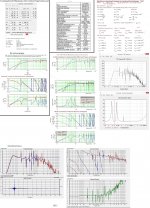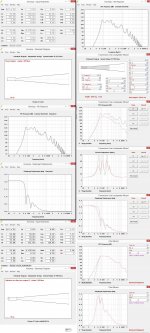Hi David,
since i have found your great pice of software, nearly all other loudspeaker calculators have gone to the recycle ...
Nowadays diplays with Full HD resolution are standard, I am missing the option to scale the graphs in Hornresp, the Hornresp window is very small compared to the diplay resolution. It would also be nice to specify a custom frequency range the it is easier to focus on the range which is important for subwoofer design.
Is there a chance to get these features in a further release of Hornresp?
+1!!!
Hi zak1976,
At this late stage in the evolution of Hornresp it would just be too much work to go back and modify everything to make the windows sizable. The formatting of controls has been carefully optimised to the current fixed window size - I would rather not change this.
Are you using the 125% magnification option with your display? I find that it makes the Hornresp window a nice convenient size on my 1600 x 900 pixel LCD monitor.
This feature has been requested before - see link below. The answer remains the same .
.
http://www.diyaudio.com/forums/subwoofers/119854-hornresp-296.html#post3239635
AkAbak of course, supports user-sizable windows and custom frequency ranges...
Kind regards,
David
I am missing the option to scale the graphs in Hornresp, the Hornresp window is very small compared to the diplay resolution.
At this late stage in the evolution of Hornresp it would just be too much work to go back and modify everything to make the windows sizable. The formatting of controls has been carefully optimised to the current fixed window size - I would rather not change this.
Are you using the 125% magnification option with your display? I find that it makes the Hornresp window a nice convenient size on my 1600 x 900 pixel LCD monitor.
It would also be nice to specify a custom frequency range the it is easier to focus on the range which is important for subwoofer design.
This feature has been requested before - see link below. The answer remains the same
http://www.diyaudio.com/forums/subwoofers/119854-hornresp-296.html#post3239635
AkAbak of course, supports user-sizable windows and custom frequency ranges...
Kind regards,
David
Hornresp Update 3410-140302
Hi Everyone,
CHANGE 1
The combined response 'path length difference' parameter value is now saved as part of the Hornresp.dat file permanent data record.
CHANGE 2
The Sample tool slider range is now 1 - 20000Hz rather than 0 - 19999Hz.
The Pattern tool slider range is now 1 - 20000Hz rather than 0 - 20000Hz.
CHANGE 3
Minor amendments have been made to the Loudspeaker and Filter wizard descriptions in the Help file.
Kind regards,
David
Hi Everyone,
CHANGE 1
The combined response 'path length difference' parameter value is now saved as part of the Hornresp.dat file permanent data record.
CHANGE 2
The Sample tool slider range is now 1 - 20000Hz rather than 0 - 19999Hz.
The Pattern tool slider range is now 1 - 20000Hz rather than 0 - 20000Hz.
CHANGE 3
Minor amendments have been made to the Loudspeaker and Filter wizard descriptions in the Help file.
Kind regards,
David
Attachments
The filter wizard is great as is but would be even better if there were even just 1 PEQ term available in the active mode of the filter wizard; one each for LP and HP when doing bandpass.
Hi Jack,
If by PEQ you mean full parametric equalisation, then it's not going to happen
Allowing second and fourth order active filters to be specified using cutoff frequency and Q factor is about as far as I am prepared to go.
Kind regards,
David
Last edited:
Greets!
Set out to make a Metronome design tutorial using HR to post here: http://www.diyaudio.com/forums/full-range/252162-modelling-metronome-hornresp.html
When I convert this design done with MJK's MathCad software though, I get a ~45 Hz impedance dip Vs HR’s ~55 Hz [both with no damping], otherwise the resonant peaks/dips line up good enough for me:
L = 55"
SO = 5"^2
SL = 90"^2
zdriver = 30"
zport = 53.25" [actually exits out the bottom]
rport = 1.5" [3" dia.]
Lport = 2.5"
Note that it’s a conical expansion, i.e. no parallel walls.
TIA,
GM
Set out to make a Metronome design tutorial using HR to post here: http://www.diyaudio.com/forums/full-range/252162-modelling-metronome-hornresp.html
When I convert this design done with MJK's MathCad software though, I get a ~45 Hz impedance dip Vs HR’s ~55 Hz [both with no damping], otherwise the resonant peaks/dips line up good enough for me:
L = 55"
SO = 5"^2
SL = 90"^2
zdriver = 30"
zport = 53.25" [actually exits out the bottom]
rport = 1.5" [3" dia.]
Lport = 2.5"
Note that it’s a conical expansion, i.e. no parallel walls.
TIA,
GM
Attachments
When I convert this design done with MJK's MathCad software though, I get a ~45 Hz impedance dip Vs HR’s ~55 Hz [both with no damping]
Hi GM,
Both Hornresp and AkAbak show the dip at ~55Hz.
It would seem that the design being simulated in Martin King's software must differ in some way from the design being simulated in Hornresp and AkAbak.
Kind regards,
David
Hi GM,
Both Hornresp and AkAbak show the dip at ~55Hz.
It would seem that the design being simulated in Martin King's software must differ in some way from the design being simulated in Hornresp and AkAbak.
Kind regards,
David
Hi David,
Agree...
b
Attachments
Hi David
I did try to sim a BLH with a small 3.3 inch speaker, I did also try to include damping because this is common in a BLH to damp reflections, but when I try it it do nothing on the graph.
Maybe there is a problem there?
Software go really professional I see, congratulations for keep the simplicity also.
I did try to sim a BLH with a small 3.3 inch speaker, I did also try to include damping because this is common in a BLH to damp reflections, but when I try it it do nothing on the graph.
Maybe there is a problem there?
Software go really professional I see, congratulations for keep the simplicity also.
Attachments
Hi David...I did try to sim a BLH with a small 3.3 inch speaker, I did also try to include damping because this is common in a BLH to damp reflections, but when I try it it do nothing on the graph...Maybe there is a problem there?...
Hi Kees,
Maybe it's like often with HR..i.e.
b
Attachments
Hi GM,
Both Hornresp and AkAbak show the dip at ~55Hz.
It would seem that the design being simulated in Martin King's software must differ in some way from the design being simulated in Hornresp and AkAbak.
Kind regards,
David
Greets!
Yeah, I got that far, but was wondering from the math used how the harmonic structure could line up with a ~10 Hz difference fundamental.
GM
I did try to sim a BLH with a small 3.3 inch speaker, I did also try to include damping because this is common in a BLH to damp reflections, but when I try it it do nothing on the graph.
Hi Kees,
Absorbent filling material can only be included in an offset driver or tapped horn Loudspeaker Wizard simulation. You will need to convert your backloaded horn to an equivalent offset driver configuration as shown by bjorno, if you wish to add damping to the horn.
I am currently looking at how much work would be involved in extending the Hornresp absorbent filling functionality to all horn types, not just offset driver and tapped horns.
Kind regards,
David
Yeah, I got that far, but was wondering from the math used how the harmonic structure could line up with a ~10 Hz difference fundamental.
Hi GM,
It seems to have something to do with how the design was modelled in the MJK software. As bjorno has shown, the MJK fundamental frequency moves much closer to the Hornresp result when the MJK model is changed.
Kind regards,
David
special thanks for "Auto S2"
Hi Flaesh,
You're welcome, I'm glad you like it
Kind regards,
David
- Home
- Loudspeakers
- Subwoofers
- Hornresp
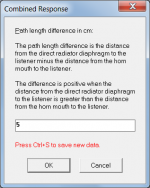
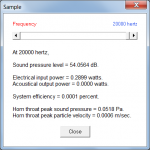
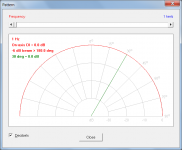
![Fostex FF165WK Metronome [ BB measured].gif](/community/data/attachments/371/371538-63a44abe5e7a073f5f990c70793081f2.jpg)
